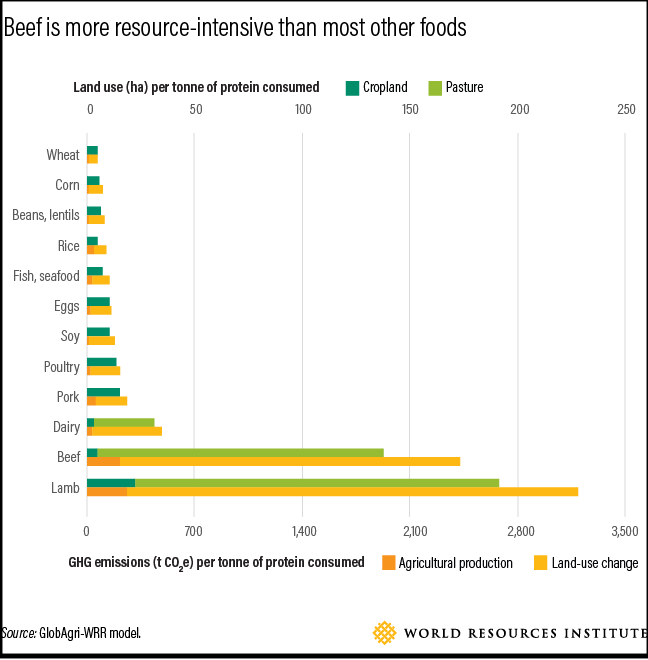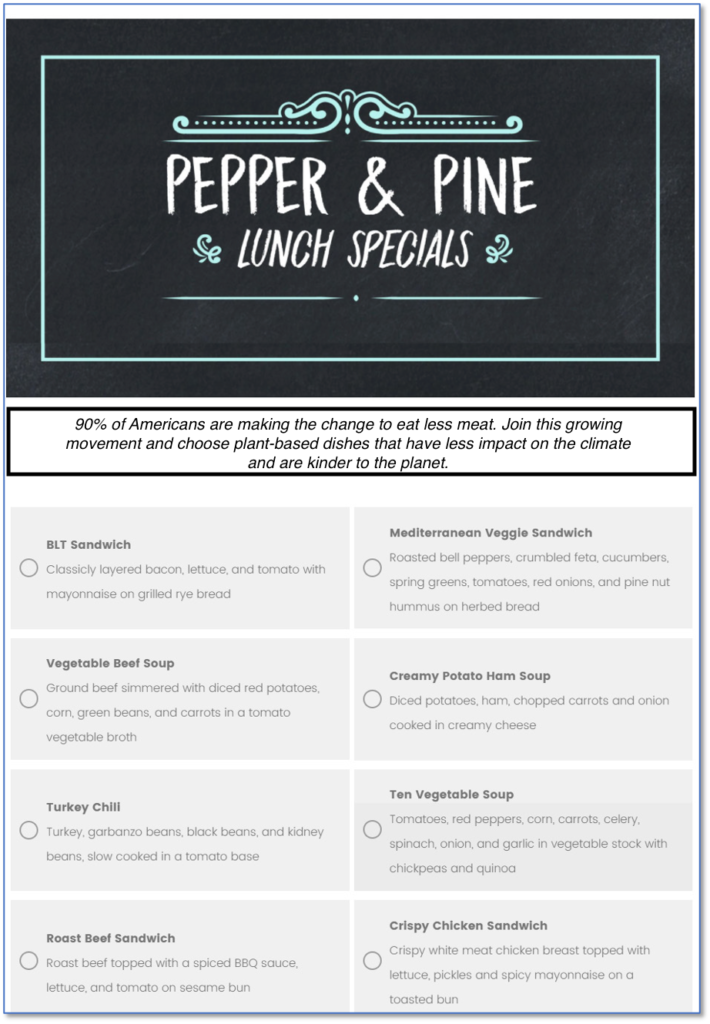The adoption of environmentally sustainable diets will have a hugely positive impact on the global food system and on our chances of living within the planetary boundaries, i.e., the safe limits outside of which the Earth system cannot continue to function in a stable state: greenhouse gas (GHG) emissions, fresh water, nitrogen cycle, biodiversity, deforestation, etc. [1]
Beyond the choices made by every individual, what more can companies do to promote the right consumer behaviour?
If you are a food service provider or a retailer, you are in the frontline of people’s everyday food choices and you can have a big influence on their behaviour.
For example, you could include a combination of tools to “nudge” [2] people to change their behaviours in a predictable way, without forbidding any options. Examples of tools available to you include: the design of your store and restaurant; the position of items in a counter; the descriptions included in your menus; the size of your dishes relative to portion sizes; labels and pack designs; and the sustainability related messages that can be added to your packaging or at the top of a menu.
These behavioural change techniques have been around for some time, but now they are being used to promote environmentally sustainable food choices.
Environmentally Sustainable diets
Around one third of GHG emissions are related to the global food system, with animal food products, especially ruminant meat, contributing massively and way above the impact of plant-based foods.
Beef production requires an average of 20 times more land and emits 20 times more GHG emissions per gram of edible protein than common plant-based protein such as beans, peas, and lentils. If the 2 billion people that today eat very high amounts of ruminant meat, reduced consumption to 1.5 servings per week, this would drastically reduce agricultural land demand, while feeding 10 billion people in 2050. [3]

There is no need to go vegetarian, but we do need to urgently review our diet and reduce our overconsumption of animal proteins, which damages the environment and our health.
How do we convince people to change their habits?
In a previous article (link) we have seen that changing behaviours is difficult, as food choices are most of the time not rational.
The vast majority of people are choosing their meal without paying too much attention to calorie counts, nutritional labels, carbon footprint, or other types of data rich communication.
Instead, they are unconsciously drawn to a dish more conveniently placed in the counter, or instinctively attracted by a message indicating a compliance to social norms.
The consequence is that, amongst the many possible interventions designed to promote the choice of healthier and environmentally sustainable diets, only a few are effective.
Ecolabels, logos, quantitative metrics on pack, certifications, do not seem to shift people’s behaviours. This may be due to overload and confusion in the consumer’s mind about what they should be doing to make a difference.
Researchers have been busy examining this topic. A systematic map of scientific papers that examine behavioural interventions for mitigating climate change through diet found that studies have increased sharply since 2015.
The categories of interventions most often studied are listed in Table 1. Although they are all having a positive impact in influencing choices, a systematic review of their relative effectiveness is yet to be undertaken. [4]
| Category of intervention | Example |
| Priming | use of visual or spatial clues in store |
| Disclosure | communication of environmental costs of eating meat |
| Social norms | emphasising what most people eat |
| Defaults | introducing meatless Mondays |
| Micro-environment changes | changing the order of choices in a menu |
The categories “disclosure” and “social norms” are making use of descriptive messages about a behaviour and its impact on the environment. These are low-investment, low-cost, and easily scalable interventions, compared to carbon and water footprint labelling.
How effective are descriptive messages to reduce meat consumption?
A study of the effect of different descriptive messages on the selection of plant-based foods from an online menu, was published in 2022 by the World Resources Institute (WRI). [5]
The results of the study showed that four descriptive messages performed significantly better than no message when added to the banner at the top of real food menus.
One of the messages resulted in a doubling of the percentage of vegetarian foods selected. It reads: “Each of us can make a positive difference for the planet. Swapping just one meat dish for a plant-based one saves greenhouse gas emissions that are equivalent to the energy used to charge your phone for two years” (Small changes, big impact).
The second-best performing message resulted in an 80% increase in the vegetarian choice and was: “90% of Americans are making the change to eat less meat. Join this growing movement and choose plant-based dishes that have less impact on the climate and are kinder to the planet” (Joining a movement).
The other two messages with a significant impact mentioned the “health and environment benefits” and “taste benefits” of the vegetarian choices. [5]

Insights for food service providers and retailers
There are many ways to encourage plant-based choices and reduce consumption of meat, especially ruminant meat, and food service providers and retailers are taking the opportunity to experiment with a number of interventions.
If this applies to you, consider implementing the following changes:
- Designing the space of your store or restaurant: add visual cues, consider the position of low carbon options in the menu, simplify access to some dishes, etc.
- Design and communicate with products and packs: consider messages, warnings, and simple labels – beware of information overload and the need for accuracy in the underlying data collection.
- Use descriptive messages: communicate the environmental costs, emphasise social norms and trends.
Although more research is needed, it seems that carefully crafted descriptive messages about the environmental impact of food choices are effective, low cost, low investment and easily scalable in the short term.
Written by Andrea Cattaruzza and edited by Sarah Wixey
References and further reading
[1] J. Rockström et al., “A safe operating space for humanity,” Nature, vol. 461, no. September, pp. 472–475, 2009.
[2] R. Thaler and C. Sunstein, Nudge – The final edition. Penguin, 2021.
[3] R. Waite, T. Searchinger, and J. Ranganathan, “6 pressing questions about beef and climate change, answered,” WRI, Apr. 08, 2019. [Online].
[4] L. A. Reisch, C. R. Sunstein, M. A. Andor, F. C. Doebbe, J. Meier, and N. R. Haddaway, “Mitigating climate change via food consumption and food waste: A systematic map of behavioral interventions,” J. Clean. Prod., vol. 279, 2021.
[5] S. Blondin, S. Attwood, D. Vennard, and V. Mayneris, “Plant-Based Food Choices: an online restaurant menu study,” 2022. [Online].



